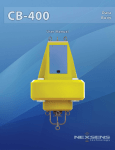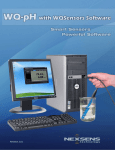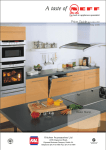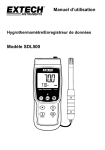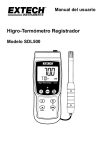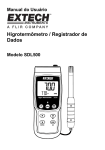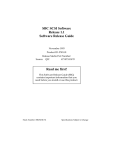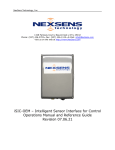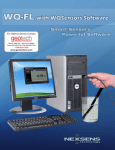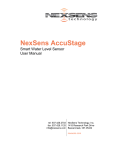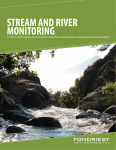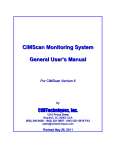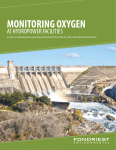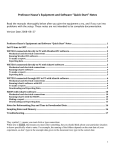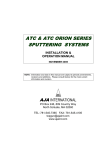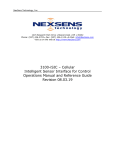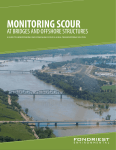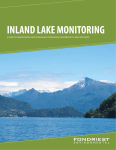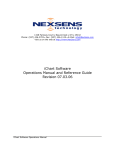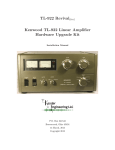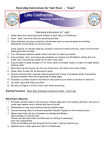Download Go to File>Properties, fill in this title
Transcript
Title Page About NexSens NexSens Technology, Inc. was founded in the late 1990s with a mission to advance the capabilities and simplify the development of environmental monitoring systems. The company specializes in environmental sensors, remote data acquisition and communications technology, easy-to-use computer software, and web based datacenters. iChart Software is an easy-to-learn, easy-to-use Windows-based software program designed to interface with the industry’s most popular environmental monitoring sensors and systems. A large multi-vendor instrument library makes setup quick and easy. iChart automates much of the tedious programming, data collection, and manual data processing common with other environmental data collection systems. The SDL500 (Submersible Data Logger) and iSIC (Intelligent Sensor Interface and Control) are state-of-the-art data loggers that simplify the collection of real-time data from environmental sensors and monitoring instruments. The data loggers support multi-vendor sensor connections and are specifically designed for environmental data monitoring. WQData PRO is an enterprise class and business critical web-based software solution for environmental data management. It assists with collecting, storing, analyzing, interpreting, sharing, and publishing environmental data. The datacenter effectively manages a wide variety of biological, physical, and chemical parameters, along with many other environmental observations and project information. WQSensors smart USB-based sensors include: Temperature, pH, ORP, Dissolved Oxygen, Ammonium, Bromide, Calcium, Chloride, Fluoride, and Nitrate. An integral USB connector on the sensor cable offers a simple, hassle-free connection to a computer without the need for a meter or batteries. T-Node temperature systems, based on sensorBUS technology, provide a simple, yet effective, plug-and-play solution for developing multi-sensor networks and temperature strings. sensorBUS was developed to replace, expand, and enhance centralized parallel wiring for prevailing analog and digital signal transmissions. With integral 1-wire, SDI-12 and RS-485 interfaces, sensorBUS provides versatile sensor networking capability. Monitoring Buoys are designed to support offshore monitoring systems. These buoys provide a robust floating platform for inland water monitoring projects. NexSens products and systems simplify the setup and operation of environmental monitoring networks and help ensure quality data. Table of Contents Overview ................................................. 1 What’s Included ..................................... 2 Common Accessories .............................................. 2 Specifications......................................... 3 Getting Started ....................................... 3 Pre-deployment Test ............................. 4 Power the Data Logger ............................................ 4 Install the Data Logger ............................................. 5 Connect Sensors ..................................................... 6 Confirm Data Collection & Transmission .................. 7 Prepare for Deployment ........................ 8 Setup the Sensor Mooring ....................................... 8 Assemble Anchor Line ............................................. 8 Safely Deploy the Buoy ......................... 9 Surface Deployments............................................... 9 Sub-Surface Deployments ..................................... 10 Satellite Buoy ........................................................................................ 10 Standalone Buoy ................................................................................... 10 Material Safety Data Sheets ................ 12 Warranty and Service .......................... 12 OVERVIEW Overview The MB-100 is designed for years of service in both surface and sub-surface applications. The data buoy's construction includes an inner core of cross-linked polyethylene foam, heavy polymer skin, and stainless steel frame. All sensor connections are made below the surface with waterproof connectors. A wireless transmitter can be positioned above the water but hidden and protected under the buoy hood. The MB-100 data buoy is designed to accommodate NexSens SDL500 submersible data loggers. A fully loaded system (with data logger and batteries) weighs just over 30 lbs. and is easily deployed by one person from any vessel. Simply attach a single-point mooring assembly and throw it overboard. The buoy will right itself and begin logging data immediately. If equipped with an optional communication package, it will start transmitting data via radio-to-shore, cellular, or Iridium satellite telemetry. Figure 1: MB-100 Data buoy 1 WHAT’S INCLUDED What’s Included The MB-100 data buoy includes a foam hull with stainless steel frame and a single mooring eye, protective foam hood, and three threaded nuts used to securing the hood. Common Accessories Table 1: Accessories commonly used with MB-100 data buoys Part Number Description Details SDL500 Submersible data logger Fully submersible data logger designed for use with NexSens data buoys. Telemetry options include cellular, radio, and satellite. DOR35 Anchor Pyramid anchor, 35 lb. DOR70 Anchor Pyramid anchor, 70 lb. SSPA375-BOW Shackle Bow shackle, 3/8” SSPA500-BOW Shackle Bow shackle, 1/2” SSPA625-BOW Shackle Bow shackle, 5/8” SS187 Stainless steel mooring line Used for buoy and sensor mooring systems. HGPC500i Chain, ½” Galvanized steel chain used for buoy moorings. 2 SPECIFICATIONS Specifications Table 2: NexSens MB-100 data buoy specifications Dimensions Hull: 18” diameter, 16” height Overall: 34” height 24 lbs (no payload) Weight Materials 38 lbs (with SDL500 and batteries) Hull, Hood: cross linked polyethylene foam with polymer skin Frame: 304 stainless steel Surface Buoyancy 100 lbs Subsurface Buoyancy 60 lbs Minimum Deployment Depth 12” Mooring Attachment ¾” stainless steel eye nut Suitable Environments Freshwater, brackish and saltwater including lakes, rivers, streams, reservoirs and coastal waters. Mooring Single point Power (8) internal D-cell alkaline batteries are used to power SDL500 data logger Getting Started The NexSens MB-100 data buoy ships fully assembled. Common accessories such as the SDL500 data logger and single point mooring hardware may require some user assembly. The buoy hood must be removed to get started. To do this, loosen and remove the three threaded nuts that secure the hood to the frame. Use 3/16” handled Allen wrench provided with the SDL maintenance kit for additional leverage if necessary. 3 PRE-DEPLOYMENT TEST Figure 2: Removing a threaded nut from the MB-100 to allow for hood removal After removing the threaded nuts, simply lift the hood off of the hull to gain access to the central buoy well. This is where the SDL500 data logger will be installed. Pre-deployment Test Prior to deployment, it is essential to test the monitoring system (sensors, data logger, and telemetry) on shore. This will allow users to familiarize themselves with the system and confirm proper operation. Power the Data Logger NOTE The SDL500 is equipped with reverse polarity protection. No damage will occur if the batteries are inserted incorrectly. Unthread the battery lid from the SDL500 communication bulkhead. Insert eight D-Cell alkaline batteries into the data logger. Note the correct polarity shown on the labels just inside the battery tubes. See the appropriate SDL500 manual for additional information. 4 PRE-DEPLOYMENT TEST Figure 3: Installing batteries in the SDL500 Install the Data Logger Remove the orange rubber o-ring from the bottom (gray) end of the data logger. Figure 4: SDL500 with bottom orange o-ring removed 5 PRE-DEPLOYMENT TEST Insert the SDL500 into the central well of the data buoy so that the white battery lid is on the topside of the buoy. Figure 5: SDL500C cellular data logger with antenna shown inserted into MB100 central buoy well Connect Sensors To facilitate sensor connections the bottom guard should be removed using the 3/16” handled Allen wrench supplied in the SDL maintenance kit. Figure 6: Removing bottom guard from SDL500 data logger using wrench from SDL maintenance kit 6 PRE-DEPLOYMENT TEST Connect sensors to the SDL500 sensor bulkhead. Refer to the appropriate SDL user manual and sensor interface manuals for additional information including port recommendations. NOTE Be sure to route the sensor cables through the guard prior to connecting to the SDL sensor bulkhead. Figure 7: SDL500 with bottom guard removed and sensors connected Reconnect the guard to the SDL500 data logger. Confirm Data Collection & Transmission Launch iChart software and confirm that the SDL500 and sensors are communicating properly. Refer to the appropriate data logger manual and iChart software manual for additional information as required. The pre-deployment check is complete. The buoy, data logger, and sensors can now be prepared for deployment. 7 PREPARE FOR DEPLOYMENT Prepare for Deployment Since the MB-100 data buoy supports 1-point moorings, the sensor mooring line also functions as the single point anchor line used for buoy mooring. Setup the Sensor Mooring NOTE Sensor mooring line should be shorter than the approximate depth of the water column. Bottom chain allows for fluctuations in water level for surface buoy applications. Lay the SDL500 data logger (pre-installed in the MB-100 data buoy) out on a flat surface. Secure the connected sensors to the sensor mooring line using sensor clamps and plastic cable ties. Figure 8: Sensor mooring line with T-Node temperature sensors and YSI water quality sonde Connect the sensor mooring line to the mooring eye on the MB-100 data buoy using a 1/2” bow shackle. Assemble Anchor Line Connect the anchor and bottom chain with a 5/8” shackle, and then attach the assembly to the sensor mooring line using a 1/2” shackle (see Figure 9). 8 SAFELY DEPLOY THE BUOY Figure 9: Typical sensor mooring and anchor line used with MB-100 data buoys Safely Deploy the Buoy WARNING Proper safety and flotation gear should be worn at all times when working on or near the water. Personnel safety should be the number one priority when deploying the buoy. Follow these steps closely to ensure safe deployment. Prior to deployment, make sure that the MB-100 data buoy, SDL500 data logger with batteries, and the sensor mooring and anchor line are securely attached in a single assembly. This is will help ensure a quick and easy deployment. Surface Deployments Water quality data is typically referenced by distance from the water’s surface. In such applications bottom mooring chain permits flucutations in water level, which effectively 9 SAFELY DEPLOY THE BUOY WARNING The buoy mooring systems are heavy and personnel can quickly become entangled with mooring lines and anchors. allows the buoy to drift along the water’s surface in the vicinity of the mooring system. To deploy a surface buoy, simply boat to the desired monitoring location and place the MB-100 buoy with data logger in the water. Allow the buoy to right itself, paying out the sensor mooring and anchor line as necessary. Make sure the anchor is still on board the boat. With the data buoy floating in location, move the boat while paying out most of the sensor mooring and anchor line and bottom chain. Drop the anchor. The data buoy is now deployed and operational. Sub-Surface Deployments Sub-surface deployments are used for bottom referencing water quality data. Data is bottom referenced when it is collected by sensors that are fixed along a mooring line in a water column that is not free to move vertically. As a result, water quality data is always collected at a fixed distance from the water body’s floor (see Figure 10). Sub-surface deployments are completed in the same way as surface water deployments. However, prior to a sub-surface deployment, it is highly recommended that the MB-100 foam hood be removed. This will lighten the buoyancy of the buoy, providing a setup that is more stable with less anchor weight. Satellite Buoy Sub-surface MB-100 deployments are most effective when used along with a larger surface buoy. In these configurations, the submersed SDL500 data logger acts as a “satellite buoy” and transmits the sensor data it collects to another SDL data logger on the surface via direct cabling. The surface data logger is typically outfitted with a remote telemetry option for automatic data upload capability. Standalone Buoy Alternatively, MB-100 data buoys can be deployed as standalone systems sub-surface. For such applications, however, the entire system including the mooring and 10 SAFELY DEPLOY THE BUOY anchor must be pulled each time batteries need changed or sensors require maintenance or calibration. Figure 10: MB-100 pictured in a surface buoy deployment (left) and a standalone sub-surface deployment (right), both deployments include YSI water quality sondes and T-Node temperature strings 11 MATERIAL SAFETY DATA SHEETS Material Safety Data Sheets Material Safety Data Sheets can be found at: http://www.nexsens.com/support/msds.htm Warranty and Service WARNING NexSens Technology, Inc. products are not authorized for use as critical components in any life support system where failure of the product may affect its safety or effectiveness. NexSens Technology, Inc. warrants products against defects in materials or workmanship for a period of 12 months from the date of delivery to the original customer. This warranty is limited to the replacement or repair of such defects, without charge, when the product is returned to NexSens Technology, Inc. Damage due to accidents, misuse, tampering, lack of reasonable care, loss of parts, failure to perform prescribed maintenance, or accidents of nature are not covered. This warranty excludes all other warranties, express or implied, and is limited to a value not exceeding the purchase price of the instrument. Limitation of Warranty This warranty is not applicable to any NexSens Technology, Inc. product damage or failure caused by (i) failure to install, operate or use the product in accordance with NexSens Technology, Inc. written instructions, (ii) abuse or misuse of the product, (iii) failure to maintain the product in accordance with NexSens Technology, Inc. written instructions, (iv) any improper repairs to the product, (v) use by you of defective or improper components or parts in servicing or repairing the product, or (vi) modification of the product in any way not expressly authorized by NexSens Technology, Inc. Corporate Headquarters and Authorized Service Center NexSens Technology, Inc. 1415 Research Park Drive Beavercreek, Ohio 45432 Phone 937.426.2703 ● Fax 937.426.1125 E-Mail [email protected] Revision: 01 Revision Date: December 2, 2010 12 WARRANTY AND SERVICE 13
















